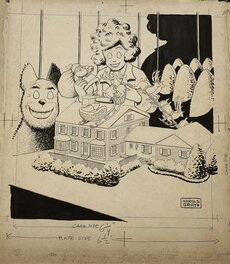Dans la collection de skymasters
Little Joe - 29 September 1935
Planche originale
1935
Encre de Chine
Ajoutée le 06/11/2025
Lien copié dans le presse-papier !

Description
Little Joe premiered in 1933 [joining] an impressive pantheon of strips that were not only beloved by Tribune readers but also enjoyed a national audience in syndication such as Gray’s Little Orphan Annie, Frank King’s Gasoline Alley, Sidney Smith’s The Gumps and Chester Gould’s Dick Tracy.
Little Joe initially carried the byline “Ed Leffingwell.” Edwin Leffingwell, who was Harold Gray’s cousin, died suddenly on October 10 1936 of a burst appendix. The strip, starting on December 13, 1936, was signed simply “Leffingwell.”. . .
But there’s every reason to believe that Little Joe was, in its initial conceptualization and in the decade after 1936 created primarily by Gray. Gray was by that point, a veteran cartoonist. Born Kankakee, Illinois in 1894, Gray studied engineering at Purdue University. After graduating, he served in the military during the First World War. After the war, he became joined the art department of the Chicago Tribune, where he had worked briefly as a reporter before his military service.
In 1924, when he was pitching the idea of Annie, Gray also tried to sell the idea of a western strip staring a young boy in 1924. When Captain Joseph Medill Patterson, co-head of the Tribune-News Syndicate went with the idea of a big-city female orphan rather than a boy in the wild west, Gray shelved Little Joe but he kept it in the back of his head for the future….
…As perhaps befitting its origins in syndication intrigue, Little Joe was a hard-bitten strip. While Edwin Leffingwell no doubt contributed his share to the work from 1933-1936, Little Joe bore all the hallmarks of a Harold Gray production: like Annie, Joe was something of a half-orphan (his father is dead, but his mother is alive) who lives in a brutal world where violence has to be met with equal force. The character Utah, a kind of adopted father to Joe, is of a piece with the many rough but fair men Gray depicted in Little Orphan Annie.
Little Joe initially carried the byline “Ed Leffingwell.” Edwin Leffingwell, who was Harold Gray’s cousin, died suddenly on October 10 1936 of a burst appendix. The strip, starting on December 13, 1936, was signed simply “Leffingwell.”. . .
But there’s every reason to believe that Little Joe was, in its initial conceptualization and in the decade after 1936 created primarily by Gray. Gray was by that point, a veteran cartoonist. Born Kankakee, Illinois in 1894, Gray studied engineering at Purdue University. After graduating, he served in the military during the First World War. After the war, he became joined the art department of the Chicago Tribune, where he had worked briefly as a reporter before his military service.
In 1924, when he was pitching the idea of Annie, Gray also tried to sell the idea of a western strip staring a young boy in 1924. When Captain Joseph Medill Patterson, co-head of the Tribune-News Syndicate went with the idea of a big-city female orphan rather than a boy in the wild west, Gray shelved Little Joe but he kept it in the back of his head for the future….
…As perhaps befitting its origins in syndication intrigue, Little Joe was a hard-bitten strip. While Edwin Leffingwell no doubt contributed his share to the work from 1933-1936, Little Joe bore all the hallmarks of a Harold Gray production: like Annie, Joe was something of a half-orphan (his father is dead, but his mother is alive) who lives in a brutal world where violence has to be met with equal force. The character Utah, a kind of adopted father to Joe, is of a piece with the many rough but fair men Gray depicted in Little Orphan Annie.
1 commentaire
Pour laisser un commentaire sur cette œuvre, veuillez vous connecter
A propos de Harold Gray
Harold Lincoln Gray, né à Kankakee (Illinois) est un auteur de bande dessinée américain. Il est surtout connu pour son comic-strip Little Orphan Annie.





